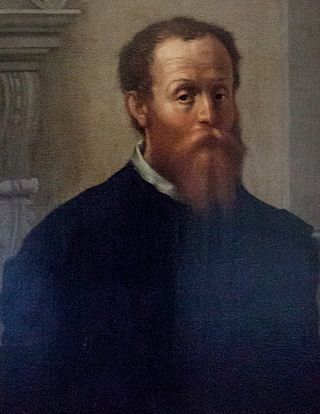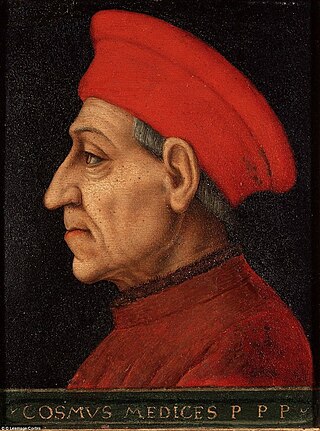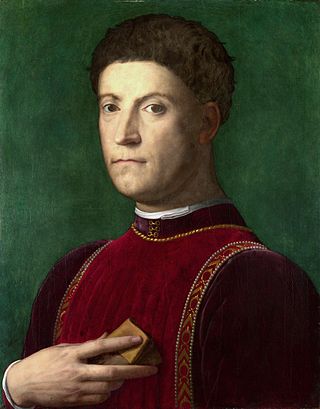Related Research Articles

Lorenzo di Piero de' Medici was an Italian statesman, banker, de facto ruler of the Florentine Republic, and the most powerful and enthusiastic patron of Renaissance culture in Italy. Also known as Lorenzo the Magnificent by contemporary Florentines, he was a magnate, diplomat, politician and patron of scholars, artists, and poets. As a patron, he is best known for his sponsorship of artists such as Botticelli and Michelangelo. He held the balance of power within the Italic League, an alliance of states that stabilized political conditions on the Italian peninsula for decades, and his life coincided with the mature phase of the Italian Renaissance and the Golden Age of Florence. On the foreign policy front, Lorenzo manifested a clear plan to stem the territorial ambitions of Pope Sixtus IV, in the name of the balance of the Italian League of 1454. For these reasons, Lorenzo was the subject of the Pazzi conspiracy (1478), in which his brother Giuliano was assassinated. The Peace of Lodi of 1454 that he supported among the various Italian states collapsed with his death. He is buried in the Medici Chapel in Florence.

The House of Medici was an Italian banking family and political dynasty that first began to gather prominence under Cosimo de' Medici, in the Republic of Florence during the first half of the 15th century. The family originated in the Mugello region of Tuscany, and prospered gradually until it was able to fund the Medici Bank. This bank was the largest in Europe during the 15th century and facilitated the Medicis' rise to political power in Florence, although they officially remained citizens rather than monarchs until the 16th century.

Baccio Bandinelli, was an Italian Renaissance sculptor, draughtsman, and painter.

Andrea del Verrocchio, born Andrea di Michele di Francesco de' Cioni, was a sculptor, Italian painter and goldsmith who was a master of an important workshop in Florence. He apparently became known as Verrocchio after the surname of his master, a goldsmith. Few paintings are attributed to him with certainty, but a number of important painters were trained at his workshop. His pupils included Leonardo da Vinci, Pietro Perugino and Lorenzo di Credi. His greatest importance was as a sculptor and his last work, the Equestrian statue of Bartolomeo Colleoni in Venice, is generally accepted as a masterpiece.

Cosimo di Giovanni de' Medici was an Italian banker and politician who established the Medici family as effective rulers of Florence during much of the Italian Renaissance. His power derived from his wealth as a banker, and inter-marriage with other powerful and rich families. He was a patron of arts, learning and architecture. He spent over 600,000 gold florins on art and culture, including Donatello's David, the first freestanding nude male sculpture since antiquity. Despite his influence, his power was not absolute; Florence's legislative councils at times resisted his proposals throughout his life, and he was viewed as first among equals, rather than an autocrat.

Cosimo I de' Medici was the second Duke of Florence from 1537 until 1569, when he became the first Grand Duke of Tuscany, a title he held until his death.

The Republic of Florence, officially the Florentine Republic, was a medieval and early modern state that was centered on the Italian city of Florence in Tuscany. The republic originated in 1115, when the Florentine people rebelled against the Margraviate of Tuscany upon the death of Matilda of Tuscany, who controlled vast territories that included Florence. The Florentines formed a commune in her successors' place. The republic was ruled by a council known as the Signoria of Florence. The signoria was chosen by the gonfaloniere, who was elected every two months by Florentine guild members.

Piero di Cosimo de' Medici , was the de facto ruler of Florence from 1464 to 1469, during the Italian Renaissance.

The Pazzi conspiracy was a plot by members of the Pazzi family and others to displace the Medici family as rulers of Renaissance Florence.

Michelozzo di Bartolomeo Michelozzi was an Italian architect and sculptor. Considered one of the great pioneers of architecture during the Renaissance, Michelozzo was a favored Medici architect who was extensively employed by Cosimo de' Medici. He was a pupil of Lorenzo Ghiberti in his early years, and later collaborated with Donatello.

Virginia de' Medici was an Italian princess, a member of the House of Medici and by marriage Duchess of Modena and Reggio.

The Albizzi family was a Florentine family originally based in Arezzo, who were rivals of the Medici and Alberti families. They were at the centre of Florentine oligarchy from 1382, in the reaction that followed the Ciompi revolt, to the rise of the Medici in 1434. They were active members of the Arte della Lana, Florence's wool guild. The Guilds played a central role in the governance of the Republic of Florence during the medieval period and guild members constituted Florence's political and economic oligarchy.
Rinaldo degli Albizzi (1370–1442) was an Italian nobleman, a member of the Florentine family of the Albizzi. Along with Palla Strozzi, he was the primary opponent of Cosimo de' Medici's rise in Florence.

Don Giovanni de' Medici (13 May 1567, in Florence – 19 July 1621, in Murano) was an Italian military commander, diplomat and architect.

Bernardo Rucellai, also known as Bernardo di Giovanni Rucellai or as Latin: Bernardus Oricellarius, was a member of the Florentine political and social elite. He was the son of Giovanni di Paolo Rucellai (1403–1481) and father of Giovanni di Bernardo Rucellai (1475–1525). He was married to Nannina de' Medici, the elder sister of Lorenzo de' Medici, and was thus uncle to Popes Leo X and Clement VII, who were cousins. Oligarch, banker, ambassador and man of letters, he is today remembered principally for the meetings of the members of the Accademia platonica in the Orti Oricellari, the gardens of his house in Florence, the Palazzo Rucellai, where Niccolò Machiavelli gave readings of his Discorsi.

Niccolò da Uzzano was an Italian politician, the Gonfaloniere of Justice in the government of Florence.

Medici is a historical drama television series created by Frank Spotnitz and Nicholas Meyer. The series was produced by Italian companies Lux Vide and Rai Fiction, in collaboration with Frank Spotnitz's Big Light Productions.
"The Dome and the Domicile" is the second episode of the TV series Medici: Masters of Florence, directed by Sergio Mimica-Gezzan and starring Dustin Hoffman and Richard Madden. It was released on 18 October 2016. It got 7.14 million viewers in Italy.
"Pestilence" is the third episode of the first season of the TV series Medici: Masters of Florence, directed by Christian Duguay and Sergio Mimica-Gezzan. It got 6.73 million viewers in Italy.

The Altoviti are a prominent noble family of Florence, Italy.
References
- ↑ "Original Sin". PoGDesign. Retrieved 6 November 2018.
- ↑ Legnaioli, Magda (21 October 2016). "Medici Masters of Florence Episode Synopses". Tuscany Sweet Life. Retrieved 6 November 2018.
- ↑ "Original Sin". Rotten Tomatoes . Fandango . Retrieved 6 November 2018.
- ↑ Lopes, Benjamin (26 October 2018). "Les Médicis, Maîtres de Florence : carton d'audience pour la série de SFR Play". Toute la Tele (in French). Retrieved 2 November 2018.
- ↑ Stefanelli, Stefania (19 October 2016). DavideMaggio (ed.). "I MEDICI SBANCANO CON IL 29.9%, LIONE-JUVENTUS RISPONDE CON IL 20.3%". Ascolti TV. Retrieved 19 October 2016.